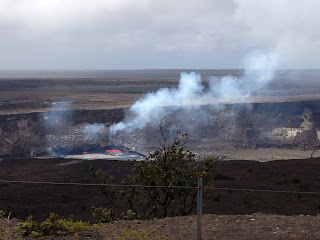When on Hawai`i Island, I was reminded of a course I took where I learned about the stages of Hawaiian volcanoes. [As as aside, this University of Hawai`i course was provided free of charge to secondary school science teachers to increase their knowledge of Hawai`i’s geology as well as geological sites of interest on Oahu. Thank you UH and the professor who created the course! It was an amazing course.]
Since the weather was so clear on Hawai`i Island, I was able to see beautiful profiles of Mauna Loa and Mauna Kea. Those profiles were such iconic examples of two different stages of the successively older volcanoes that the Hawaiian islands go through as the continental plate moves over the Hot Spot. Mauna Loa is in the main shield stage and Mauna Kea is in the post-shield alkalic stage. Life Stages of Hawaiian volcanoes Great animated video on life stages
 |
Mauna Loa / from Jaggar museum parking lot / February 2016
|
 | |
|
 |
The Hot Spot is part of a theory which, in conjunction with Plate Tectonic theory, explains how the Hawaiian Island chain was formed. The Hot Spot is a “deep and fixed” area where the Earth’s rocky layer below the Pacific Plate melts resulting in magma. Geology discussion The melted magma, with varied properties and movements, created our Hawaiian Island chain from island to seamount. When the whole Hawaiian Island range is examined, it is much more extensive than many realize and it shows over millions of years how islands grow and subside. Map of whole Hawaiian island chain
 |
Kohala volcano / from airplane / February 2016
|
 |
Four of the five Hawai`i Island volcanoes / from airplane / February 2016
|
It is very exciting to be able to view from land, as well as fly over the Hawaiian Islands, and see geological history encapsulated as you travel down the island chain. Hawai`i Island is especially great as you can see three stages all on one island. This time as I flew away, I was able to get some great views of Kohala, which is in the erosion / reef building stage. There are nice views of the stream eroded amphitheater valleys.
The last photos show Maui and Oahu. I believe Haleakalā, Maui’s large mountain, is also in the post-shield alkalic stage.
 |
Maui isthmus / from airplane / February 2016
|
 |
Haleakalā / from airplane / February 2016
|
The Oahu photos show the view of the Waianae mountains I see whenever I drive to and from home and the final shot shows the view from my home. Oahu is in the rejuvenation stage which comes after the erosion / reef building stage. The Waianae mountains are heavily eroded and shaped and include valleys on the far side some of which are due to landslides. The rejuvenation stage is evidenced by our many prevalent small craters which dot the lower areas of Oahu, like Diamond Head and Punchbowl craters in the view from my home.
 |
Waianae range / from road / February 2016
|
 |
| Diamond Head and Punchbowl / from my porch / February 2016 |
So as always, nature is all around us! Some of it is larger, and much older, than we can even conceive. But if we have the opportunity to travel to other islands, or just look again at what we have around us, we can see evidence, and gain understanding, of our natural, our growing and changing very own island home as part of Earth!
Please visit my Nature - Around Hawaii page for my last “watching outs” from my Hawai`i Island trip. It is about ecological succession and new birds that I saw on Hawai`i Island!




















